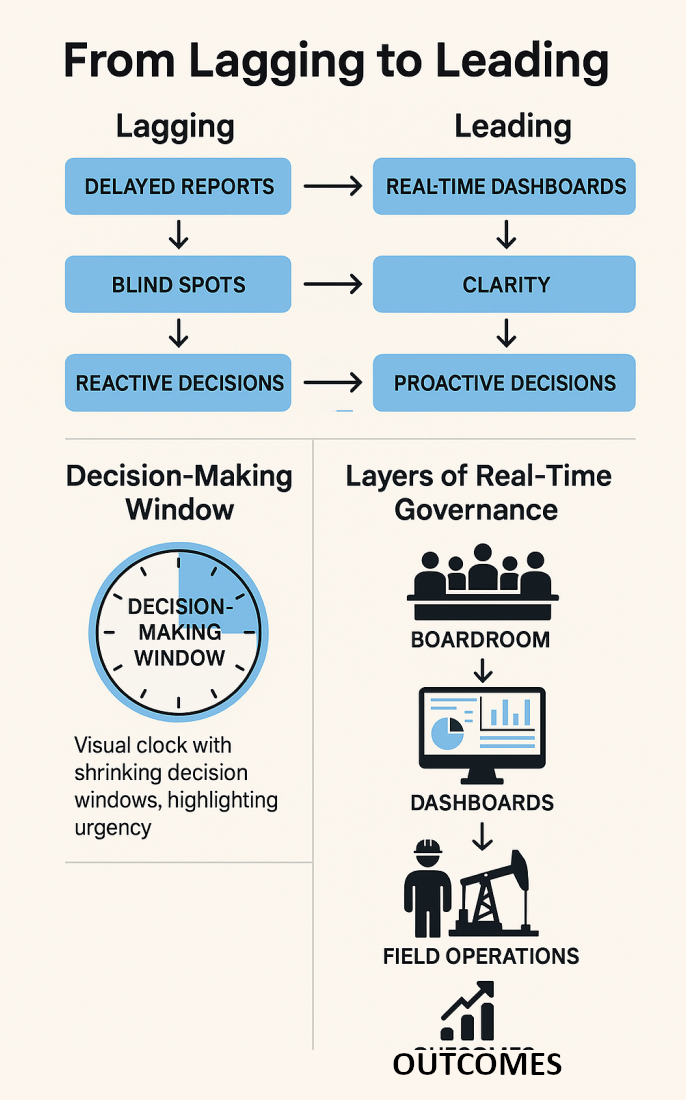Governance at the Speed of Business
In industries where capital risk is high and operations never stop, the traditional cadence of governance—monthly reviews, quarterly board packs, post-mortem reporting—is no longer sufficient. Leadership today must operate with real-time awareness. In mining, oil & gas, and heavy equipment sectors, governing in real time is not just a competitive edge—it’s a survival requirement.
Lagging Data Equals Lagging Decisions
Delayed data creates blind spots at the highest level. By the time cost overruns, downtime spikes, or compliance breaches reach the boardroom, the damage is done. Relying on spreadsheets, email chains, or static PDFs means your insights are always out of date. When governance is backward-looking, leadership becomes reactive. In fast-moving environments, strategic decisions must be made with real-time dashboards and forward-looking confidence.
Real-Time Visibility Drives Real-Time Accountability
Imagine a world where CFOs can monitor cash flow by entity in real time. Where COOs can spot production anomalies as they occur. Where CIOs can track adoption and compliance dashboards dynamically. This isn’t hypothetical—it’s possible with integrated BI, ERP, and operational data environments. And when leaders have visibility, teams have focus. Accountability doesn’t require more pressure—it requires better clarity through best practices for real-time predictive dashboards.
Boards Must Rethink Their Role in Data Strategy
Traditionally, boards reviewed outcomes. Today, they must shape the systems that deliver those outcomes. This means asking not just about performance, but about visibility. Are we seeing the right KPIs, in the right format, at the right frequency? Are our dashboards built for insight or compliance? Data governance is no longer an IT issue—it’s a board-level responsibility tied directly to operational intelligence and competitive posture.
Risk Management Starts With Live Intelligence
In asset-heavy sectors, risks escalate quickly: equipment failure, safety incidents, regulatory breaches, cost blowouts. Managing these risks requires more than risk registers—it requires live operational intelligence. Boards must move beyond red-yellow-green snapshots and into predictive alerts, scenario analysis, and AI-powered forecasting. Governance in real time means acting before events become problems—not explaining them after.

Decision-Making Windows Are Shrinking
In volatile markets, leadership windows close fast. The difference between a timely decision and a missed opportunity could be millions. Real-time governance is not about micromanagement—it’s about micro-moments of clarity. When leadership teams have access to reliable, consolidated, and contextual data, they act decisively. And in today’s landscape, decisiveness is strategy.
Strategic Oversight Requires Operational Precision
You can’t manage what you can’t see—and you can’t lead what you don’t understand. Governing in real time is about connecting the boardroom to the field, the financials to the workflow, the risk to the outcome. With live, role-specific dashboards and embedded analytics, leadership is no longer stuck in rearview analysis. It becomes a forward-driving force—confident, accountable, and aligned.
